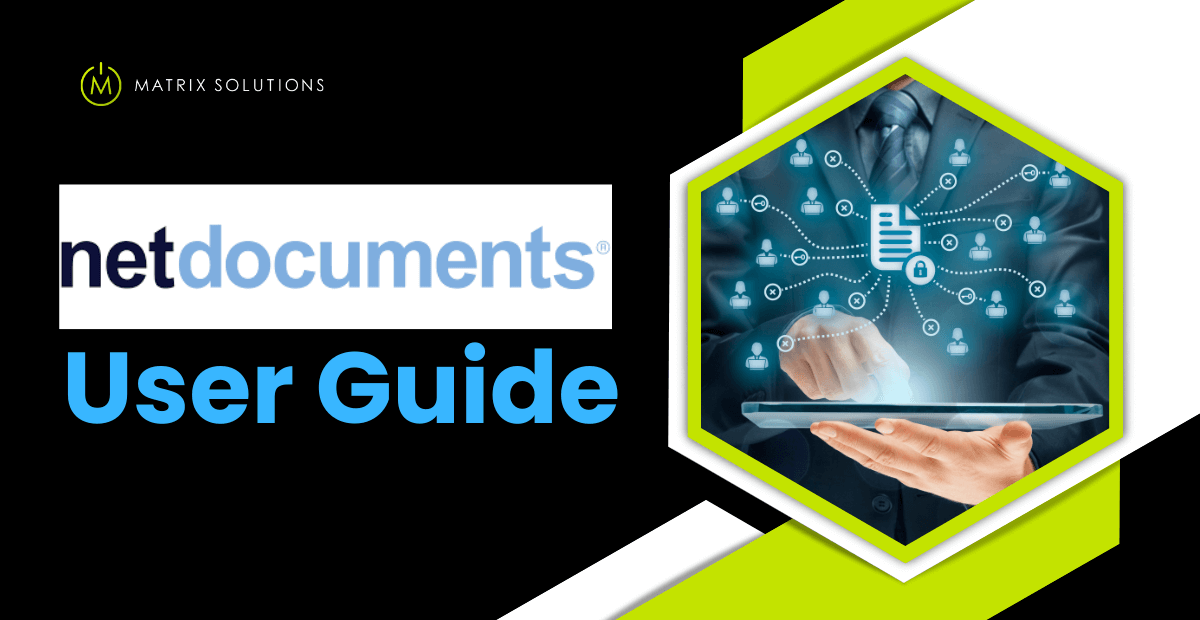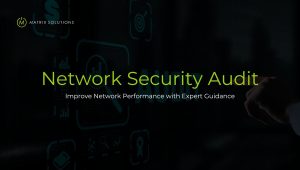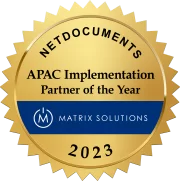NetDocuments, a trusted cloud-based document management system (DMS), delivers a consistent and secure platform for all law firms and legal consultants. It empowers individuals to enhance collaboration in a safe digital environment. With the expertise of matrix solutions, you can grip your knowledge and experience to optimise your document management operations.
In this “NetDocuments user guide” section, you can understand the platform comprehensively and enhance your document management experience from its base. Here, we provide a complete overview of the various guides available in NetDocuments and available to users. With the help of this trustful user guide, you can fully utilise its potential to simplify your workflow and gain valuable knowledge on how it can benefit you. So, Let’s explore the various guides available in the NetDocuments:
‘Getting Started Guide:
This ‘Getting Started’ guide is one of the perfect, foremost guiding platforms for users new to NetDocuments. With this guide, you can quickly become familiar with the fundamental aspects of NetDocuments. It provides step-by-step directions with essential features and functionalities. This guide covers:
- Account setup
- Document uploading
- Folder organisations
‘User Interface’ Guide:
The User Interface Guide dips more in-depth into the interface and layout of NetDocuments. It provides detailed information on various elements within the platform, such as the toolbar, navigation pane, search bar and document preview options. You will gain valuable insights and access the different features available to you. The user interface guide helps to optimise workflow and strengthen the user-friendly design of NetDocuments.
‘Collaborating’ Guide:
Collaboration is a crucial aspect of document management. It mainly explains the effective way of sharing documents and collaborating with coworkers. It usually covers document-sharing permissions, version control, and real-time features. In this guide, you will enhance your communication and increase productivity within your legal team.
‘Advance Features’ Guide:
Advanced Features Guide is a helpful resource for users looking to analyse advanced functionalities of NetDocuments. This guide examines advanced search techniques, document automation, email integration, and integrations with other software applications. You can unlock the full prospect of NetDocuments to meet your specific requirements.
What is NetDocuments?
NetDocuments is a cloud-based document management system(DMS) designed specifically for the legal industry. It is a web-based document and email management service delivered through SaaS, established in 1999. NetDocuments is a powerful and secure platform that enables law firms to securely store and manage documents and collaborate with co-counsels and clients.
With NetDocuments, you can reduce unmanageable manual document handling and adopt a streamlined digital workflow. NetDocuments allows you to store, organise, create, and access your documents from anywhere at any time.
Setting Up Your Account
Setting up your account is crucial before optimising the features and benefits of NetDouments. In this section, we will guide you through the account setup process. Following the steps below in this guide, you can create a NetDocuments account and customise it to suit your needs.
Let’s explore the process of setting up your NetDocuments account:
Creating an Account
To begin your journey with NetDocuments, you need to create an account. The process of creating an account is simple and user-friendly. The steps involved in creating an account are as follows:
Steps:
Visit the NetDocuments Website:
- First, you need to visit the official NetDocuments website. Look for the “Sign Up” or “Create Account” button to begin the account creation process.
Provide Required Information:
- You need to provide accurate information while creating an account. The necessary information typically includes your name, email address, and a secure password. It’s crucial to choose a strong password to protect your account.
Verify Your Email:
- After you provide information, you will receive an email from NetDocuments to verify your email address. After that, you need to verify your email by clicking the verification link provided in your mail account.
Complete other Additional Details:
- Once your email is verified, you will be asked to provide further details, such as your organisation’s name. These details help customise your account settings.
Check and Accept Terms of Service:
- Carefully review the terms of service or user agreement presented to you. Before moving forward, it’s crucial to understand and agree to the terms of the user agreement given to you. If you have any questions or concerns, seek clarification from NetDocuments’ support team.
You can also fill our form to reach us for the correct guidance.
Set Up Security Measures:
- NetDocuments takes security concerns seriously. During the account creation process, you may be encouraged to set up security measures, such as two-factor authentication (2FA) or security questions.
Access Your Account:
- You did it! You have successfully created your NetDocuments account. Now, you can log in using the credentials you provided during the account creation process.
Accessing Your Account
To access your NetDocuments, you need to follow these important steps:
Find the username menu.
- In the upper right corner of the NetDocuments interface, you will find a username menu. Click on the down arrow next to your username to open the menu.
Select “Admin”:
- You need to choose “Admin” from the options displayed in the username menu. It will direct you to the administration settings of your NetDocuments account.
Navigate to the “External Drives” Tab:
- You can see the “External Drives” tab in the Admin section. Click on it to access the settings related to external drive integrations.
Open the “NetDocuments” Tab:
- Within the “External Drives” tab, locate the “NetDocuments” tab. Click on it to open the settings for integrating NetDocuments with other applications.
Click on “Register”:
- In the “NetDocuments” settings, you will find a “Register” button. Click on it to start the registration process.
Provide NetDocuments User and Password:
- A prompt will appear, asking you to provide your NetDocuments username and password. You need to enter these credentials accurately.
Grant Permission and Enter Access Code:
- Next, you will be prompted to grant permission for the integration, allowing the application (in this case, RSign) to access your NetDocuments files. After granting permission, you will receive an access code.
Enter the Access Code:
- Finally, enter the access code generated by the integration (RSign). This code establishes the connection between RSign and your NetDocuments account.
Using the Dashboard
Dashboard in NetDocuments is the main backend for managing and accessing documents and tasks. It offers a range of additional features designed for task management and overall productivity tools.
The main theme of using a dashboard is providing users a centralised location to navigate and access their documents and tasks conveniently. It eliminates the need to navigate multiple folders or search for specific files, saving valuable time and streamlining workflow.
Likewise, the Dashboard enables users to track and manage their specific tasks effectively. It may include task management features such as task assignment, task priority settings, and task completion status. With these credentials, you can stay on top of your tasks, collaborate with team members, and ensure timely completion of important assignments.
Logging In and Out
To access NetDocuments, you need to log in and out securely. After that, you can enter your credentials and verify the user account. So, follow these steps:
Logging In:
- First and foremost, you need to access the login page. To do so, open your web browser and navigate to the NetDocuments login page. You can find this on the official NetDocuments website.
- After, you can enter credentials with your username and password in the required fields. Before verifying, make sure to enter the correct information.
- After entering credentials, Click the “log in” button to initiate the login process. Here, NetDocuments will verify all your credentials.
- Now, you need to verify your account. If it’s your first time logged in or additional verification is required, NetDocuments may remind you to complete a multi-factor authentication process or provide other verification steps.
- Finally, following all these crucial steps, you will be granted access to your NetDocuments account upon successful verification.
Logging Out:
- Once you finish using NetDocuments, discover the logout option within the platform. You can find this in the account settings or user profile section.
- Click on the “Log Out” option to begin the logout process. This action confirms that you are securely logged out of your account.
- NetDocuments may prompt you to confirm ‘log out’. You can confirm your intent to log out to complete the process.
It is crucial to securely log out of the NetDocuments system after each session, particularly when accessing sensitive information. Logging out ensures unauthorised individuals cannot access your account and confidential documents.
Editing Your Profile and Password Settings
In NetDocuments, you can edit your profile and password settings to customise your user experience. You need to follow these steps to make modifications:
Access Profile Settings:
Once you log into your NetDocuments account, navigate to the user profile section. For this, click on your username or profile picture, normally in the interface’s top-right corner. Select “Profile” or “Profile Settings” to access your settings.
Edit Profile Information:
You can edit details, including your name, contact information, job title, and other relevant information. Make the desired changes and save your updated profile information.
Modify Password Settings:
To change your password, find the password settings section within your profile settings. This section may be tagged as “Password” or “Security”, depending on the platform layout. Choosing a strong and unique password for enhanced security would be best.
Regarding the modified user of documents processed by Symphony OCR, it’s essential to note that the user may change to the next user that Symphony OCR is running as. However, by default, NetDocuments preserves the modified user of the document when using Symphony OCR. This default setting ensures that the document’s original author is owned, even after OCR processing.
Connecting to Other Accounts
NetDocuments allows users to connect their accounts to other platforms for seamless integration and collaboration. By linking accounts, users can enjoy various benefits and enhance their productivity.
Let’s explore the different steps and benefits of connecting to other accounts.
Account Integration:
To connect your NetDocuments user account with other platforms, such as email clients, document management systems, or task management tools, navigate to the integration settings within your NetDocuments account. You can look for various options related to platform integration or connected accounts.
Linking User Accounts:
You must follow the instructions to link your NetDocuments user account with the desired platform. It involves authentication credentials, granting permissions, or configuring specific settings to establish the connection.
Seamless Collaboration:
Once you establish an integration, you can experience seamless collaboration between NetDocuments and the connected platform.
For example, integrating with an email client lets you directly attach documents from NetDocuments to your emails.
Improved Productivity:
Connecting your NetDocuments user account to other platforms enhances productivity by simplifying workflows. This integration enables efficiency and ensures you can work seamlessly across different applications, saving time and effort.
Managing Documents
Managing the documents is a crucial step for each organisation. Nowadays, most of the companies are leading their work management remotely. A strong document management system becomes even more important in such a situation. So, let’s dive into the process of uploading a document management system and discover how it can help you update your system to work.
Uploading Documents to the System
In the modern era of remote and hybrid work, small firms recognise the importance of updating their document management systems. NetDocuments offers a streamlined process for uploading documents, ensuring ease and efficiency. Here are the steps involved:
- First, you must Log in to your NetDocuments account using your credentials. You can get access from any location, either for remote or hybrid work.
- Navigate to the upload section within the NetDocuments interface. Here, you can find the upload section or button.
- Select the documents you want to upload to the system. Do this by browsing your local device or selecting files from connected cloud storage services.
- Customise your documents during the upload process. You can add metadata, assign relevant tags, and specify other details.
- The next step is to select the desired location within NetDocuments where you want to store the uploaded documents.
- Click on the “Upload” button to initiate the document upload process. If you do so, NetDocuments will transfer the selected files to the designated location within the system.
- After, you can monitor the upload status and track the completion of individual files.
- Finally, once the upload is complete, NetDocuments will confirm the successful transfer of your documents. You can then access and manage these documents from anywhere.
Creating Folders and Sub-Folders
NetDocuments provides additional features to create folders and sub-folders. Some major steps to follow while creating it are as follows:
- First, you need to access the folder management feature. To do this, once you are logged in to your account, you can navigate to the area where folder management is available. There is the option named “folders” or “organise”.
- In the folder management feature, locate the option to create a new folder, represented by a “New Folder” button or an icon with a plus (+) sign. Click on it to initiate the folder creation process.
- Enter a name for your new folder. Choose a descriptive name that defines the purpose of the folder.
- If you want the new folder to be an existing one, select the parent folder from the available options. But this step is optional.
- Click the “Save” button to save the newly created folder. NetDocuments will now display the folder in the designated location within the folder structure.
Assigning Permissions and Sharing Documents
Once you have created the preferred folders and sub-folders, you can set access permissions to control who can view, edit, or collaborate on the documents within each folder.
It is crucial to assign permissions and share documents effectively to ensure document security, especially in the permanent hybrid workspace where remote and in-office collaboration is common.
Here are the steps for granting permissions, setting document-level security, and sharing documents with internal and external levels.
For granting permissions:
- First, you must navigate to the document or a folder you need to manage.
- You can access the document properties or right-click on the document to find the “Permissions” or “Sharing” option.
- From there, you can specify who can view, edit, or collaborate on the document.
For setting document-level security:
- NetDocuments provides various options to enhance document security through document-level security settings.
- Doing this allows you to restrict access to sensitive documents and limit editing abilities.
For sharing documents with internal users:
- First and foremost, to share documents internally, you can use ‘NetDocuments’ built-in collaboration tools.
- Here, you can create shared workspaces, collaborate on documents in real time, and maintain version control.
For sharing documents with external users:
- We can share documents with external users, such as clients, co-counsel, or external partners.
- You can send password-protected links or secure email attachments directly from the platform.
- These secure sharing methods ensure that only authorised external users can access the shared documents, protecting your sensitive information.
Searching for Documents with Powerful Filters
NetDocuments offers search features with powerful filters to help you find your documents more efficiently. Utilising these features, you can refine your searches and locate the exact documents you need. You need to follow these useful steps sharply to search your documents with powerful filters effectively:
- Locate the search box within the NetDocuments interface.
- Enter the search query in the respective search box. You can search by document properties like title, author, or client name. Include relevant keywords related to the document you’re looking for.
- After, click the magnifying glass icon or hit Enter to execute the search. NetDocuments will process your query and generate search results based on the selected criteria.
- NetDocuments will present a list of search results matching your query. Each result will display key information, such as the document title, author, date modified, and location within the folder structure. If fulfilled, Scan through the results to identify the document you need.
- There is an additional option if your search causes a large number of results. Use advanced search options, such as Boolean operators (AND, OR, NOT), to further narrow down your results.
- To handle an error message, if your search query returns no output or generates an error message, review the question once or check if the search criteria are correctly entered.
Viewing Documents in the System
In NetDocuments, viewing documents in the system is a consistent process that offers various features and options for effective document management. Let’s look at the breakdown of how to view documents of the system’s functionalities:
- Users can navigate through their documents and folders using the folder structure. Just click on folders to access their contents to find specific documents based on keywords.
- NetDocuments provides powerful search capabilities, allowing users to search for specific documents within their accounts. Without wasting time, utilise the search bar and enter relevant keywords to limit your search results.
- Additionally, NetDocuments offers filtering options. Here, users can apply filters based on various document attributes, such as author, date modified, or document type.
- NetDocuments includes a streamlined document mark-up viewer that enhances document collaboration and review processes. It allows users to highlight or add comments directly to the document without changing the original file.
Adding Tags, Notes, and Comments to Documents
In NetDocuments, you can enhance document organisation and collaboration by using tagging, note-taking, and commenting features. Here’s how to access these functionalities effectively:
- To add tags to a document, simply locate the document within the NetDocuments system.
- Click on the document to open it, and look for the “Tags” or “Add Tags” option. Enter relevant keywords to categorise the document based on specific criteria.
- When viewing a document, find the “Notes” or “Add Note” option. Click on it to open the note-taking interface, where you can enter text, highlight specific sections, or attach additional comments.
- When viewing a document, find the “Comments” or “Add Comment” option. Click on it to open the comment section, where you can leave remarks and suggestions or ask relevant questions about the document’s content.
Exporting Documents from the System
NetDocuments allows users to export documents from the system in various formats. The necessary steps to export records are listed below:
- First, select the desired documents containing the folder you want to export.
- If you want to export all documents, select the specific documents by clicking their checkboxes or using the “Select All” option.
- Once the documents are selected, locate the export options or settings. Choose the desired export format based on your requirements.
- After selecting the export format, initiate the export process by clicking the “Export” button. NetDocuments will begin processing and converting the desired documents into the specified export format.
- Once you finish the export process, NetDocuments will provide a download link to save the exported documents to your local device. Follow the instructions to download or save the files.
- After downloading or saving the exported documents, unlock them using the appropriate software to verify they are properly exported and maintain the desired formatting.
Document Security
In NetDocuments, document security is the set of features that are specially data privacy. Document security can control access to your documents, implement data encryption and track document activities. They are designed to protect your sensitive information and ensure.
Further, document security prevents unauthorised access and data breaches. By prioritising document security, NetDocuments provides a secure and dependable platform for managing and collaborating on your critical documents.
Access Control Settings
NetDocuments’ access control settings provide flexible and secure document access management within an organisation. Varying access through NetDocuments needs can be adapted, ensuring only authorised users can view, edit, or collaborate on specific documents.
Symphony OCR, when incorporated with NetDocuments, proposes an additional benefit by preserving the modified user of the document. Symphony OCR is a component in NetDocuments and Worldox that allows you to convert scanned documents and images into searchable and editable text.
When selecting the “Preserve modified user and date” checkbox in the NetDocuments Integration Settings page, Symphony OCR provides accurate attribution of document modifications and improving faults.
Protecting Against Security Breaches & System Attacks
NetDocuments handles extensive measures to protect against security breaches and system attacks, ensuring the highest level of protection for your sensitive data. The platform incorporates strong security features such as encryption, two-factor authentication, and continuous monitoring to detect and reduce potential threats.
NetDocuments uses different security models, enabling customised access control for varying document groups. Administrators can easily configure approvals based on roles to set up user access and role management, confirming that users only have access to the documents necessary for their work. Organisations can confidently extend collaboration by following the proper guidelines and techniques while maintaining data security and privacy.
With these security features, NetDocuments provides a secure and trustworthy environment for managing your documents, protecting against security breaches and system attacks.
Setting Up User Access & Role Management
In the NetDocuments user guide, setting up user access and role management is a straightforward process that authorises organisations to control document permissions efficiently. NetDocuments offers five access levels: View, Edit, Share, Administer, and No Access. All of them are introduced below:
View: Users with “View” access can read and download documents but cannot make any changes.
Edit: Users with “Edit” access can modify documents and save changes.
Share: Users with “Share” access can share documents with others, granting them the appropriate access level.
Administer: Users with “Administer” access can manage document settings, user access, and other administrative tasks.
No Access: Using “No Access” to a document makes it invisible to users or groups, providing strict document privacy.
Further, to set up user access and role management, administrators can follow these steps:
Define Roles:
Identify user roles within your organisation, such as employees, managers, or external partners, and determine the appropriate access levels for each role.
Assign Permissions:
For each document group or folder, assign the relevant access levels to the related user roles.
Manage External Access:
If collaborating with external users, specify access levels and permissions accordingly, maintaining control over document sharing.
Communicate Changes:
Maximise user adoption by informing all users about the new document management system.
Working with External Users & Public Sector Clients
NetDocuments delivers a smooth and secure way to collaborate with external users and public sector clients. To work with external users, you need to follow these crucial steps:
- Invite external users by sending them an “invitation link” or “email”. Specify the preferred access level, such as “View,” “Edit,” or “Share,” to grant appropriate permissions.
- Customise access levels based on the specific requirements of each external user. Ensure that they can only access the documents relevant to their collaboration.
- Securely share and track documents, mitigating the risk of unauthorised access.
NetDocuments offers several benefits that help increase public sector clients’ efficiency. With secure permission settings, public sector clients can maintain control over sensitive information and ensure compliance with regulations.
NetDocuments offers several benefits that help increase public sector clients’ efficiency. Public sector clients can use secure permission settings to control sensitive information and ensure compliance with regulations. Working with external users in public is safe, enabling efficient collaboration while protecting crucial data.
Permissions & Sharing
NetDocuments provides various permissions and sharing features to boost secure and efficient collaboration. The different permissions and sharing options available in NetDocuments are listed below:
- View
- Edit
- Share
- Administer
- No Access
NetDocuments provides five permission levels. They are:
- View:
The user can view a document, folder, discussion, and workspace in this option. Further, you can:
- Download a copy of a document.
- You can add documents to a cabinet.
- Edit:
Here, the user can:
- Modify the contents of documents in a Cabinet or shared space.
- Create or modify versions of a document.
- Edit a document’s profile, including renaming the document.
- Add new documents (not subfolders) into a folder.
- Remove (unfile) documents from a folder.
- Add a Saved Search.
- Share:
A user can:
- Share a document in a Cabinet with other users of the Cabinet.
- Share a ShareSpace or CollabSpace with other users (inside or outside the Cabinet).
- Add users to the access list up to but within your access.
- Administer:
A user can:
- Delete a document, a ShareSpace, Collabspace or a folder.
- Delete a version of a document.
- Add people to the Access List.
- Change the rights of users already in the Access List.
- Remove other users from the Access List of a document, Workspace, or ShareSpace.
- Rename a folder.
- No Access:
Here, documents are invisible to users or groups, ensuring strict privacy. A user cannot:
- View a document, ShareSpace, CollabSpace or folder, etc.
- Depending on their rights, one user may see several documents in a folder, while others may see only one or no documents in the same folder.
Granting Access:
Users can choose individuals or groups to grant access and set appropriate permission levels to documents, folders, or workspaces.
Revoking Access:
If access needs to change is complete, users can easily revoke access to specific documents or modify permission levels.
Modified Dates & Modified Users of Documents in NetDocuments
In NetDocuments, tracking the modified dates and modified users of documents is specific. To view this information, you can simply navigate to the document’s properties to find the relevant data.
NetDocuments maintains a clear record of document modifications, showing the date and the user responsible for the changes.
Further, when integrating with Symphony OCR, the “Preserve modified user and date” checkbox in the NetDocuments Integration Settings page ensures that the modified date of a document is maintained. This feature enhances accuracy and accountability.
NetDocuments Folder Import Tool
To address the error message “No Internal Users group was found for the selected repository” in the NetDocuments folder import tool, you need to follow these steps :
- Go to the Advanced Tab:
When encountering a similar error, navigate to the Advanced Tab in the NetDocuments folder import tool.
- Select NetDocuments Resources:
In the Advanced Tab, look for the option “NetDocuments Resources.” Select this option to enable the import tool to identify the Internal Users group.
Removing a User in NetDocuments
To remove a user in NetDocuments, follow these simple steps:
Find the User:
Go to the user management section in NetDocuments and find the user you want to remove from the system.
Select and Delete:
Check the box next to the user’s name to select them, and then click on the “Delete” button. Confirm the deletion when pressed.
Easily Add Back:
Unfortunately, when a user is deleted, there is no need to worry. NetDocuments allows easy re-addition of users, ensuring that no critical data is lost during the process.
Importance of Symphony OCR:
For documents processed by Symphony OCR, preserving the modified user and date is crucial. Selecting the “Preserve modified user and date” option in the NetDocuments Integration Settings provides accurate attribution of document modifications.
Conclusion
In conclusion, NetDocuments offers a comprehensive solution for managing documents securely and efficiently, particularly suited for law firms and legal professionals. To further enhance your experience, consider partnering with Matrix Solutions. As a leading provider of Managed IT Services, Matrix Solutions offers managed document management services that integrate seamlessly with NetDocuments, ensuring optimal performance and support. Trust Matrix Solutions will help you maximise the potential of your document management system and secure your business’s future.
Ready to simplify your document management with NetDocuments? Contact us for masterful service and boost your productivity today!







